This article contains expert-led insights from a previous season of the Million Dollar Case Study. MDCS is a free, comprehensive video series by Jungle Scout in which veteran Amazon sellers show budding entrepreneurs how to succeed on Amazon—by actually doing it. The series takes viewers step by step through the process of launching a real product on Amazon in real time—from product research to finding a supplier to advertising. Check out our most current season here for the latest information on selling on Amazon.
In this episode, we cover how to ship your product to Amazon warehouses.
- What is a freight forwarder? Do you need a freight forwarding company?
- How to create your shipment plan in Amazon?
- Timelines, pricing, and expectations
- Missed an episode? See them all here.
We’re covering all of this today in our eighth episode of the Million Dollar Case Study. Watch the video and keep reading!
Subscribe to the Million Dollar Case Study list here, so you never miss an episode!
Before you get started, if you’re not already using Jungle Scout (an all-in-one platform for selling on Amazon), you will need to get a Jungle Scout subscription to follow along with us and complete your product research.
Welcome Back to the Million Dollar Case Study!
For this episode, I interviewed Michael Gallardo from Flexport. Michael has years of experience in the shipping industry and explained how to get our private label product from China into Amazon warehouses.
How do I ship my goods from China to an Amazon warehouse?
A good place to begin is with the weight of the shipment. These are some of the rules I always stick to:
- For ocean shipments, always use a freight forwarder
- For air shipments, use a freight forwarder if your cargo weighs more than 200 kg
- If your cargo is less than 200 kg, then you can go through your supplier, who will leverage DHL Air Express
- Freight forwarders are too expensive for shipments of less than 200 kg
What is the difference between FCL and LCL?
The most typical ocean shipment is an LCL (Less Than Container Load) shipment. You’re going to be in an LCL shipment if your shipment is less than 18 cbm (cubic meters). Think about it as the space your product takes up as opposed to the weight.
If you’re in this category, it means your product will be in a container with other shippers’ products. That container will be shipped to the United States and then offloaded at a container freight station before the cargo is prepped and sent to Amazon fulfillment centers.
This is where a freight forwarder comes in handy!
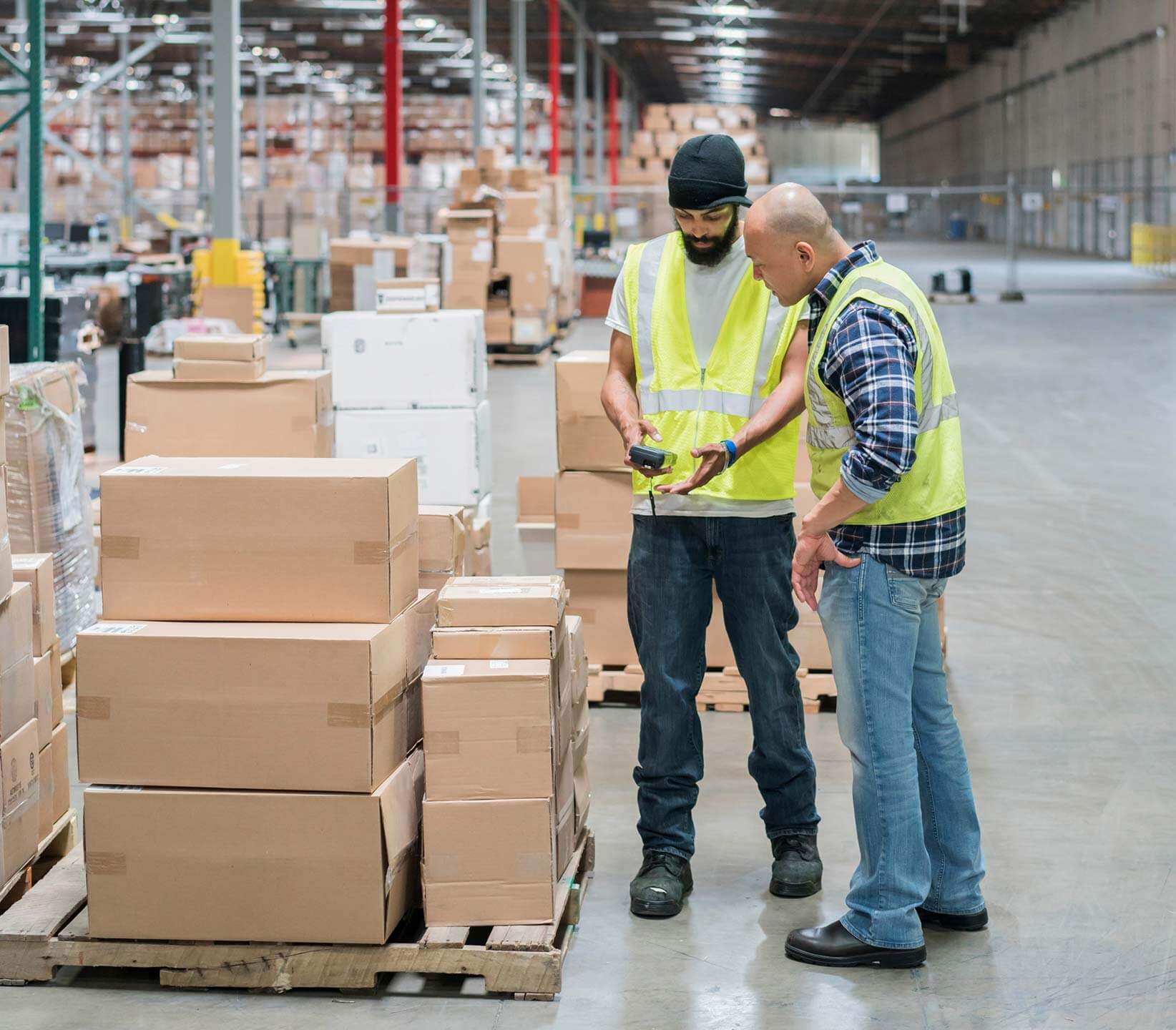
If your shipment is over 18 cbm, that’s when I’d be working with your freight forwarder to see if FCL (Full Container Load) makes sense. Typically FCL ships direct to an Amazon warehouse without unloading the container.
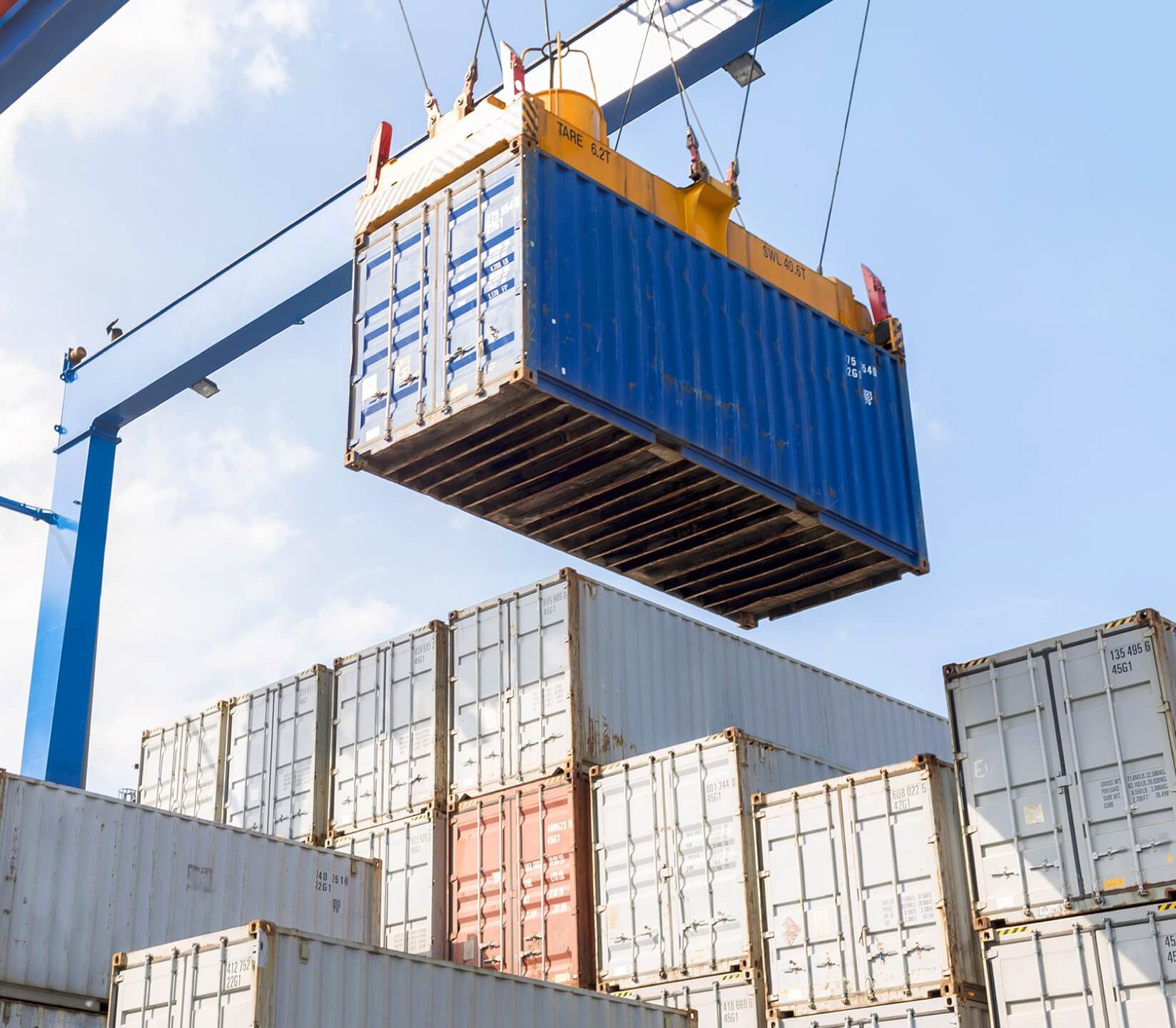
What are shipping container sizes?
If you were wondering how much you would need for FCL, here’s a list of the container sizes available:
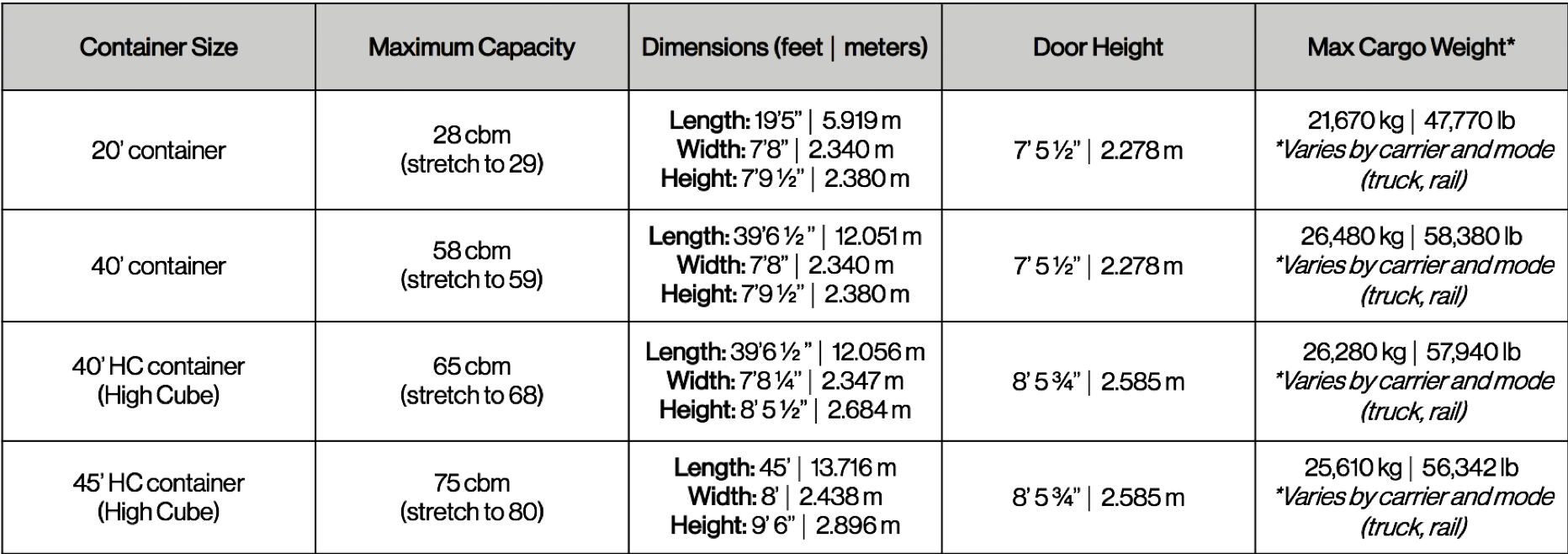
What is the difference between air shipping and sea shipping?
Another consideration is to ship via air, which is usually a much faster and simpler process. But, it can be expensive. The chargeable weight is the weight which airlines will use when determining the cost of a shipment, and the carrier will charge you for whatever is greatest: gross weight or volumetric weight.

How do I have my imports inspected?
To ensure quality, always have your shipment inspected overseas by an independent third party, even if you have shipped with your supplier multiple times.
Recommended solutions:
💡PRO TIP: try to negotiate (ahead of time) with your supplier for them to pay for the second inspection if the first inspection fails.
How do I create an Amazon shipping plan?
When you are shipping goods to Amazon, you must create a shipping plan in the Seller Central platform in order to get the correct addresses and information and ensure Amazon knows about your inventory and there are no setbacks in getting the inventory into Amazons warehouse.
Shipment plans do not expire so it helps to set them up well in advance. Let’s walk through setting one up!
First, from your home screen, you’ll want to select “Manage Inventory” from the “Inventory” tab.
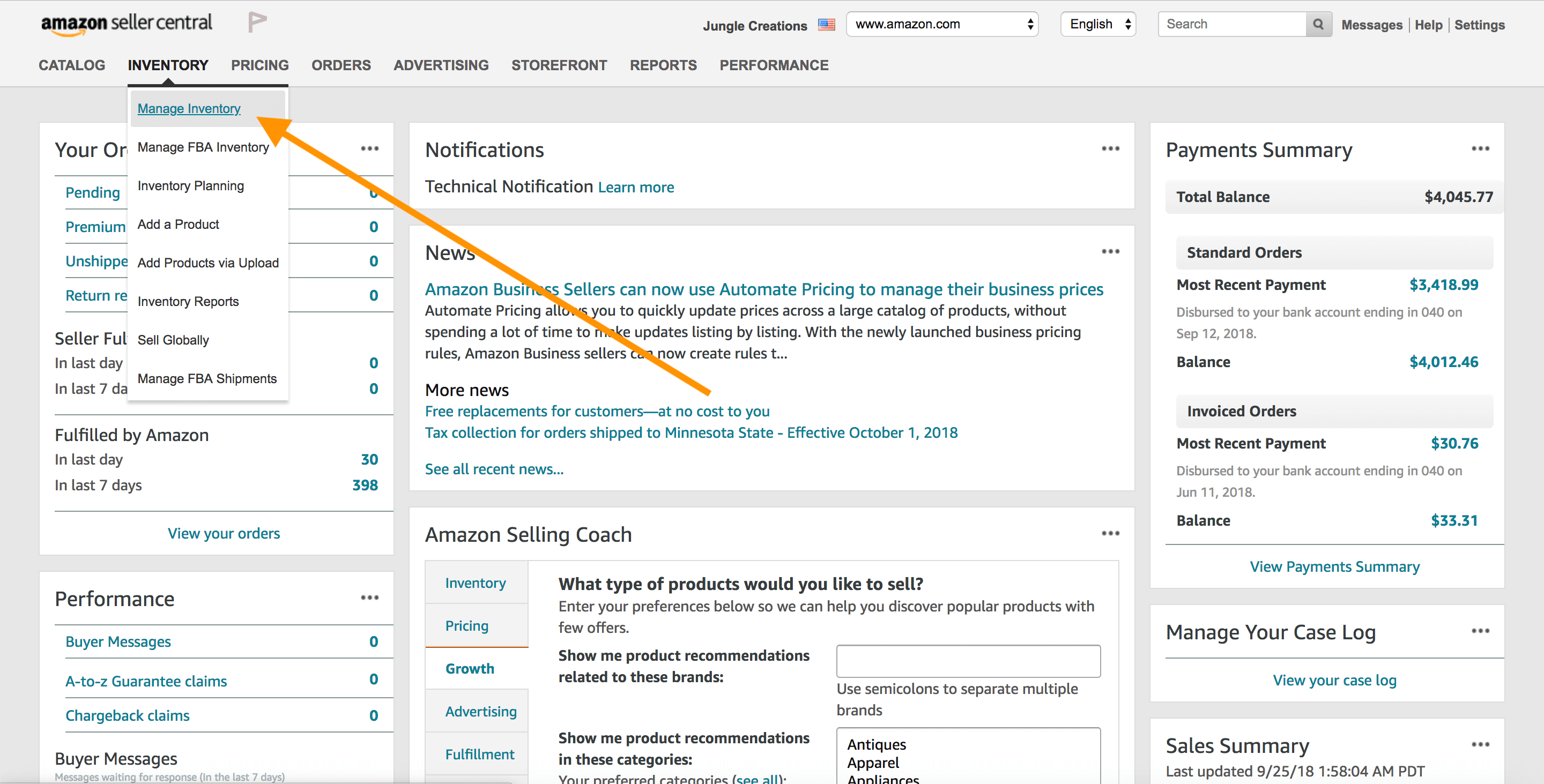
This brings us to all current product listings (next week we cover how to create the perfect product listing). From here we’ll navigate to the “Edit” button.
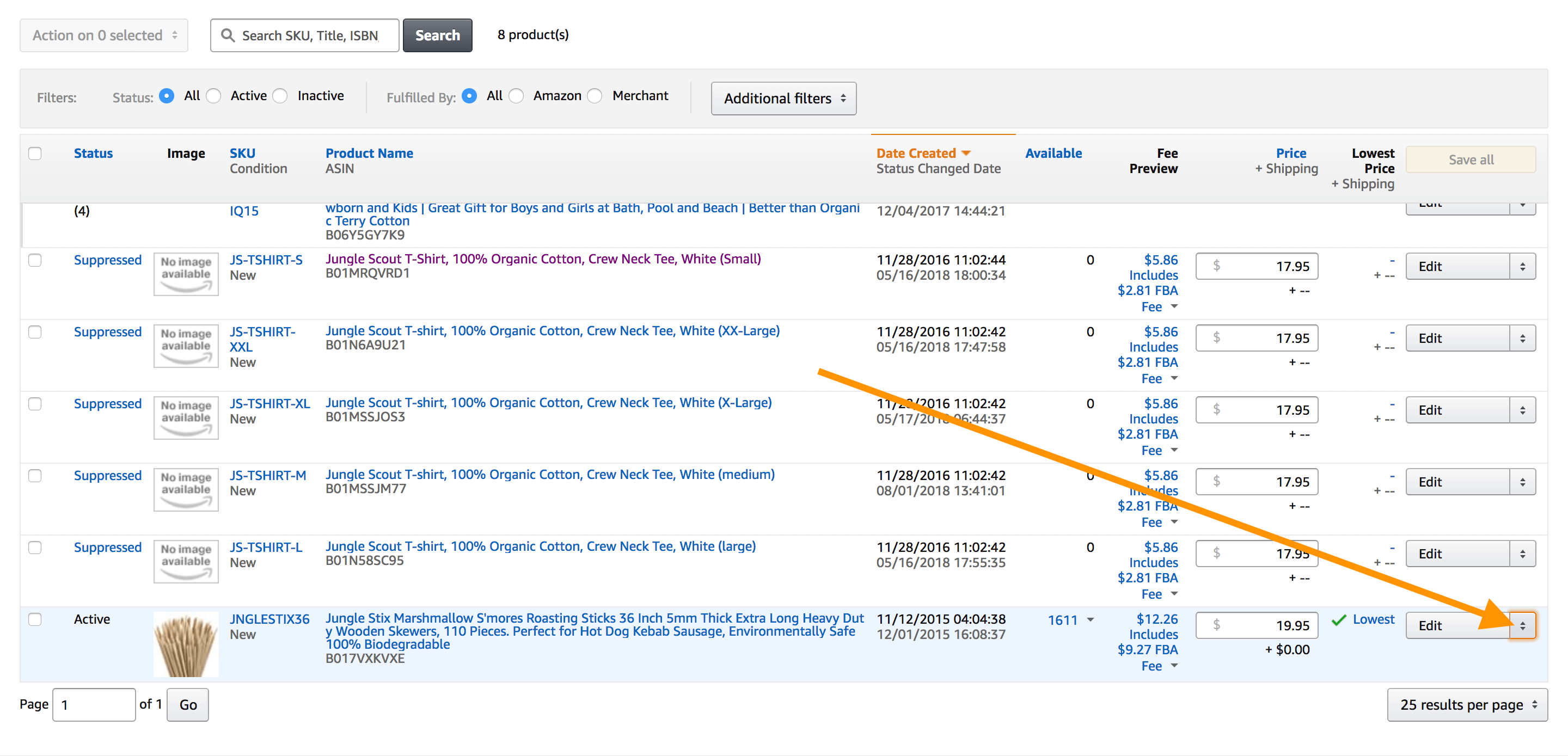
Next, we select “Send/Replenish inventory”
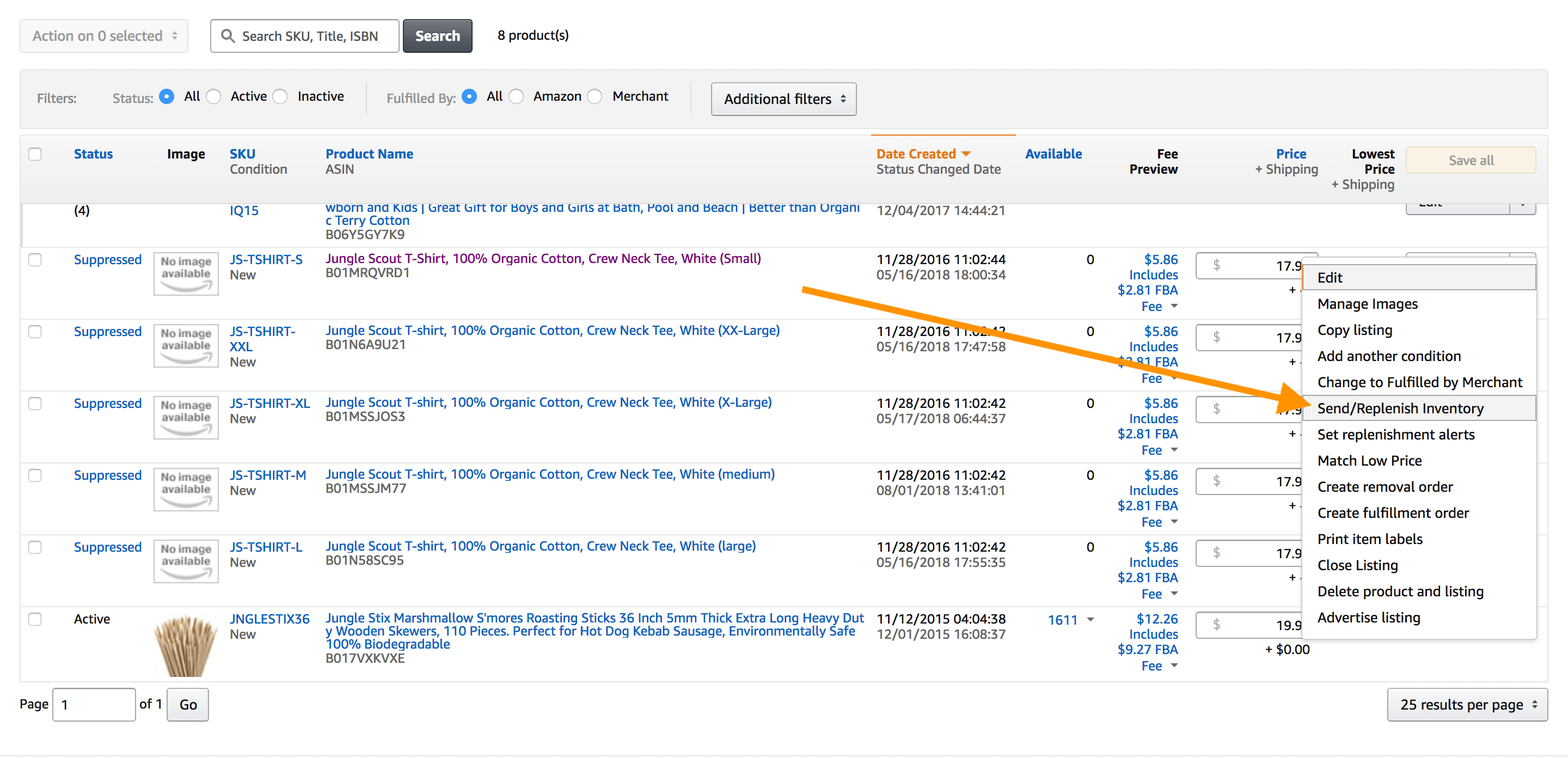
In the following screen, we need to give Amazon some more information:
- Select “Create a new shipping plan”
- Enter the ship from address. It’s important to note that the “Ship from” address is the location from which your shipment will be picked up for final delivery to an Amazon fulfillment center.
- The location of the Ship From warehouse often determines the location of the Amazon fulfillment center you’re assigned
- Do not use the supplier’s address. Use the final destination your product will land at before going to Amazon – like the offloading warehouse at the port of entry.
- Select “Case-packed products”. Be sure to put all SKUs into one shipment plan.
- Shipment plans do not need to be broken down by SKU; if you break them down by SKU, Amazon may split your shipment into more fulfillment centers than necessary
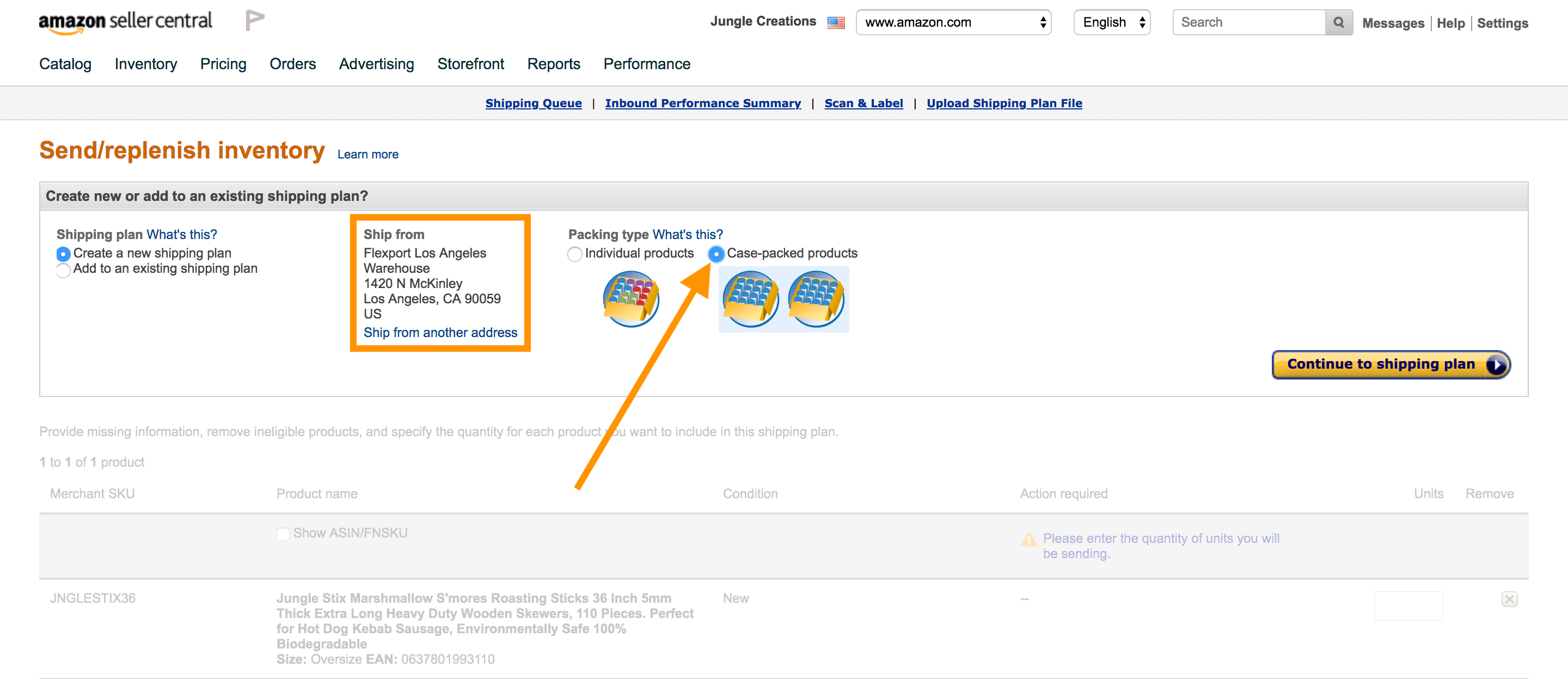
Next, we input the units per case and the number of cases. This information should be readily available from your supplier.
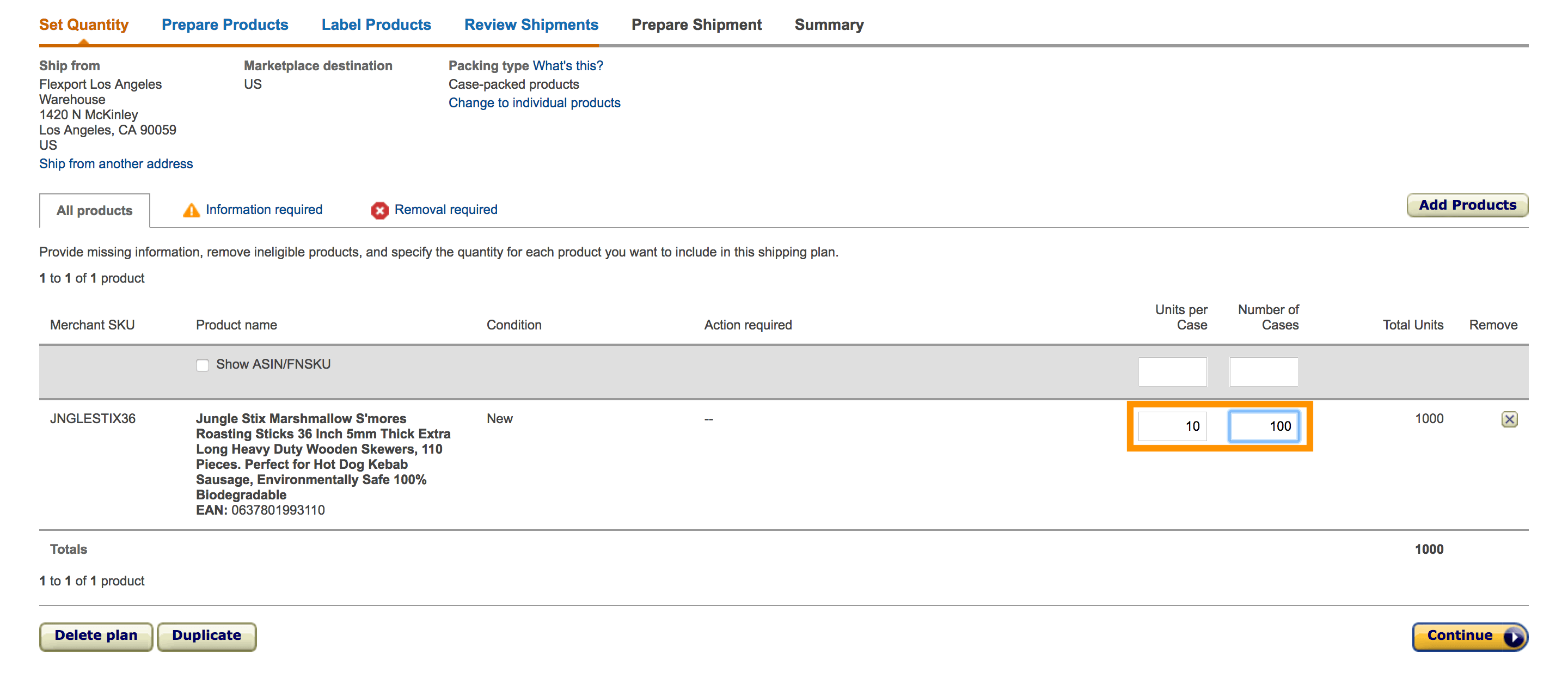
Next, Amazon wants to know if they will be doing the packaging prep work (bubble wrapping, bagging, etc.) or if it will come ready for customers. I would highly advise you always have your supplier do all the packaging prep work as it is always the more affordable route. If you’re curious to know what Amazon charges then you can check out their pricing here.
Let’s select “Merchant,” since we are having our supplier do the prep work.
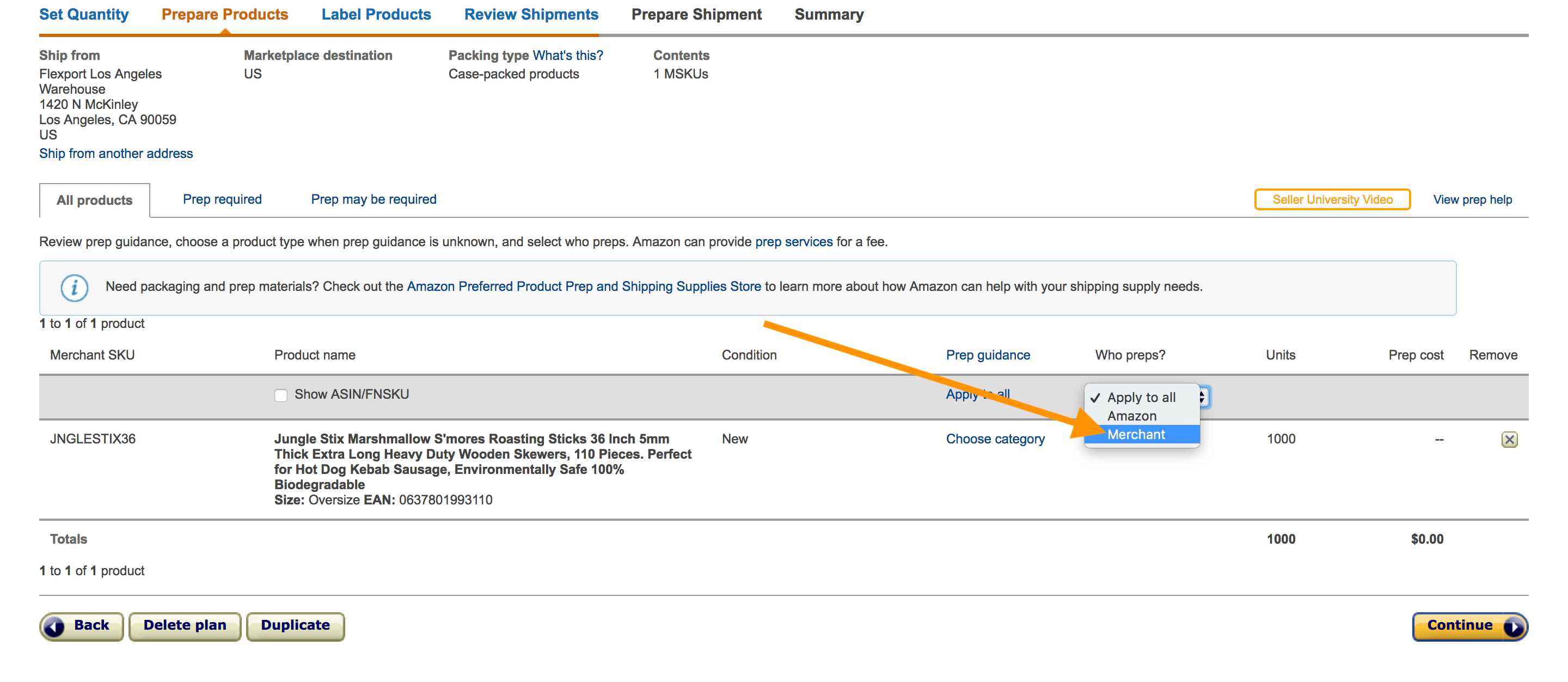
Now, Amazon is asking if they will be applying the FNSKU (an Amazon-specific barcode/identifier, we cover this in last weeks episode) labels on our product (at a fee). Once again, we want the supplier to handle this for us.
However, before we advance from this screen we want to make sure that we select the “Print labels for this page” button in order to get a PDF file of our FNSKU. This is the file we would provide our manufacturer so they can add the FNSKU/barcode to our packaging.
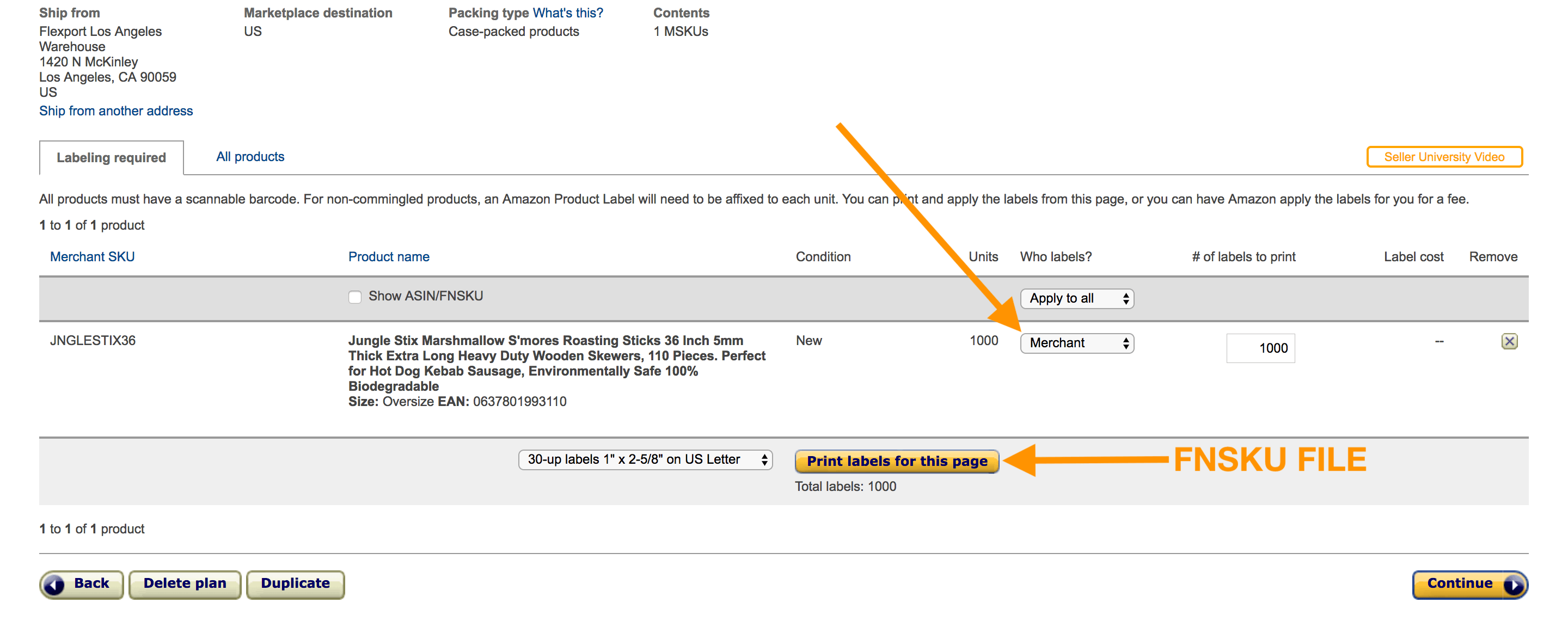
Amazon will automatically designate the fulfillment centers they want our product shipped to. As you can see below, my 100 case shipment has been split up into 3 locations: Pennsylvania, Florida, and Washington (unfortunately we don’t have a say in how this is divided up).
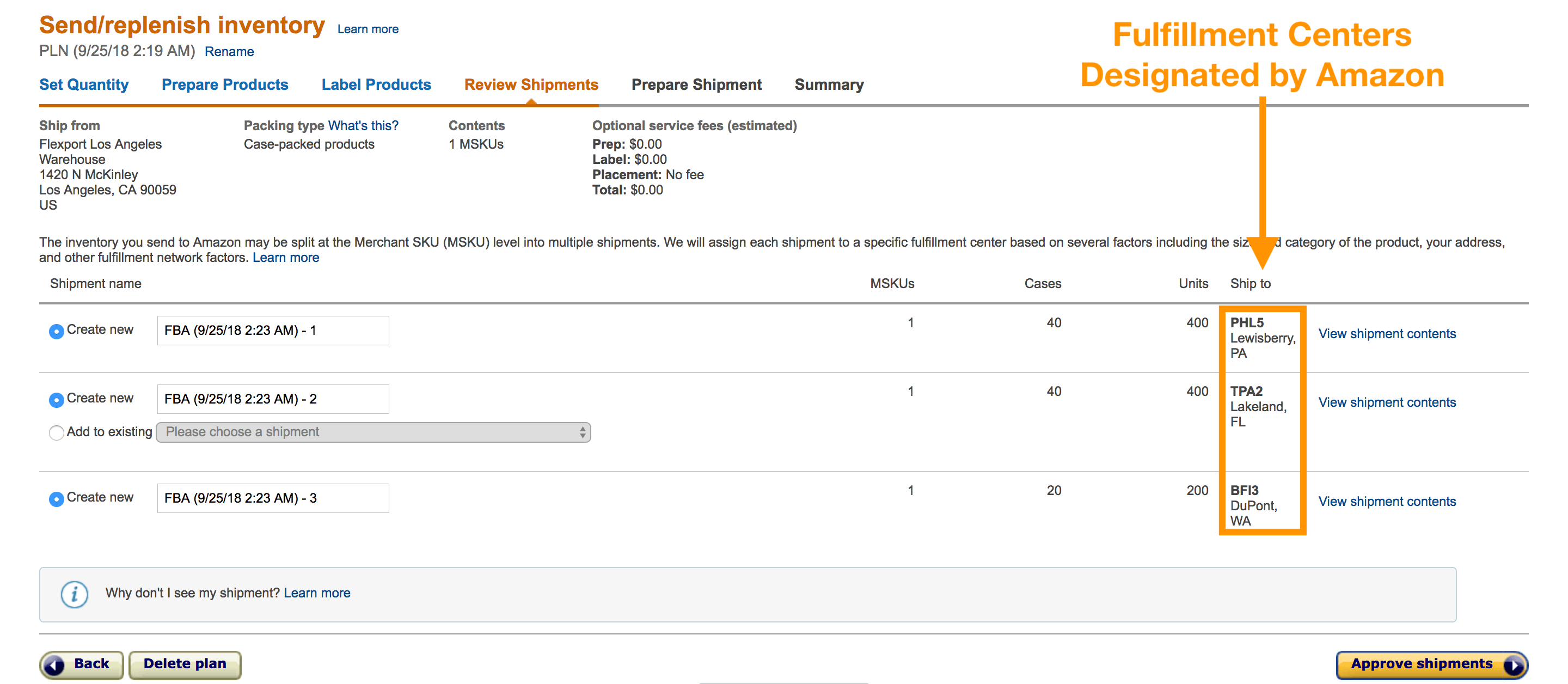
Once, I’ve approved the shipments, then I can begin to work on each shipment plan independently.
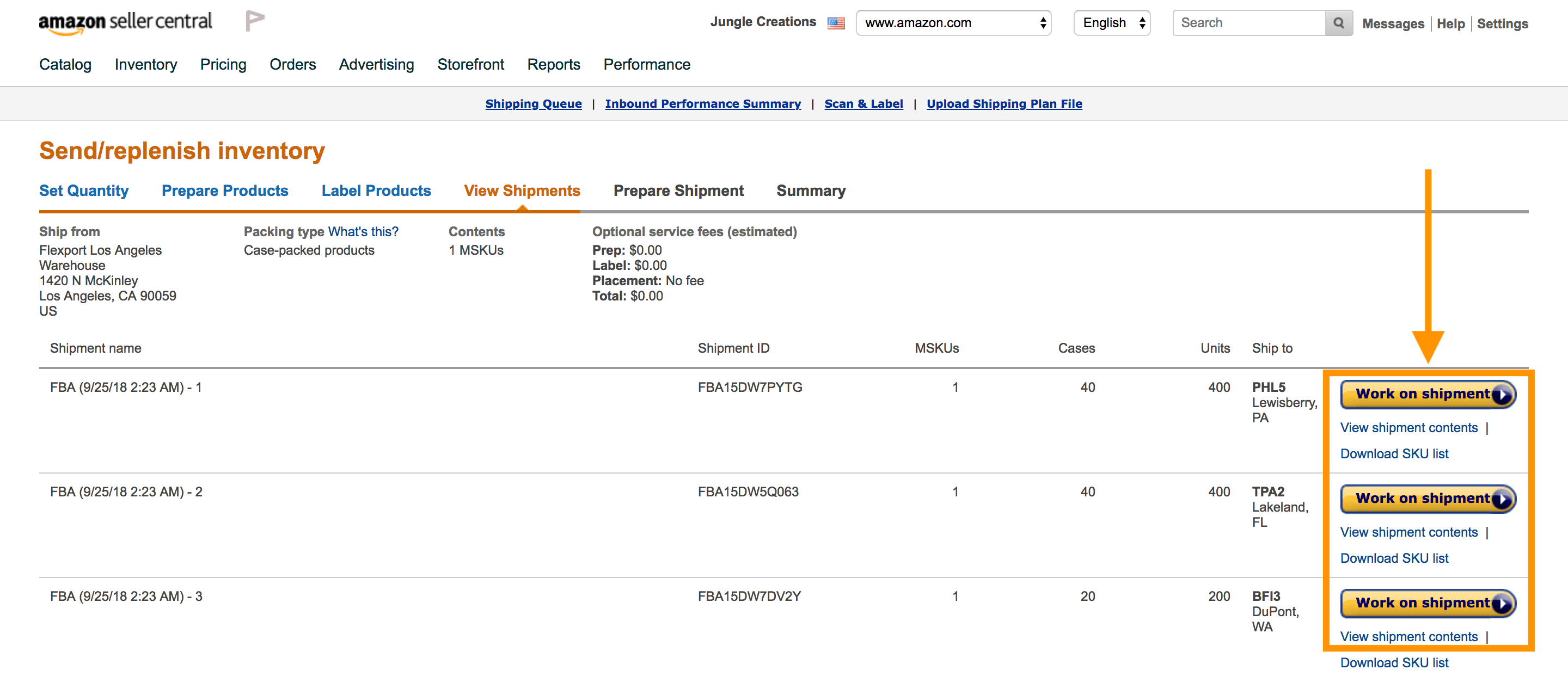
Lastly, we are taken to the Center Replenish Inventory page. This is how to get our goods from the freight forwarder’s distribution center to Amazon’s distribution center. You’ll notice here there are two main shipping methods: “Small parcel delivery (SPD)” and “Less than truckload (LTL).”
If it’s less than 30 cartons, you’re going to use SPD. If it’s greater than 30 cartons, then you can use LTL.
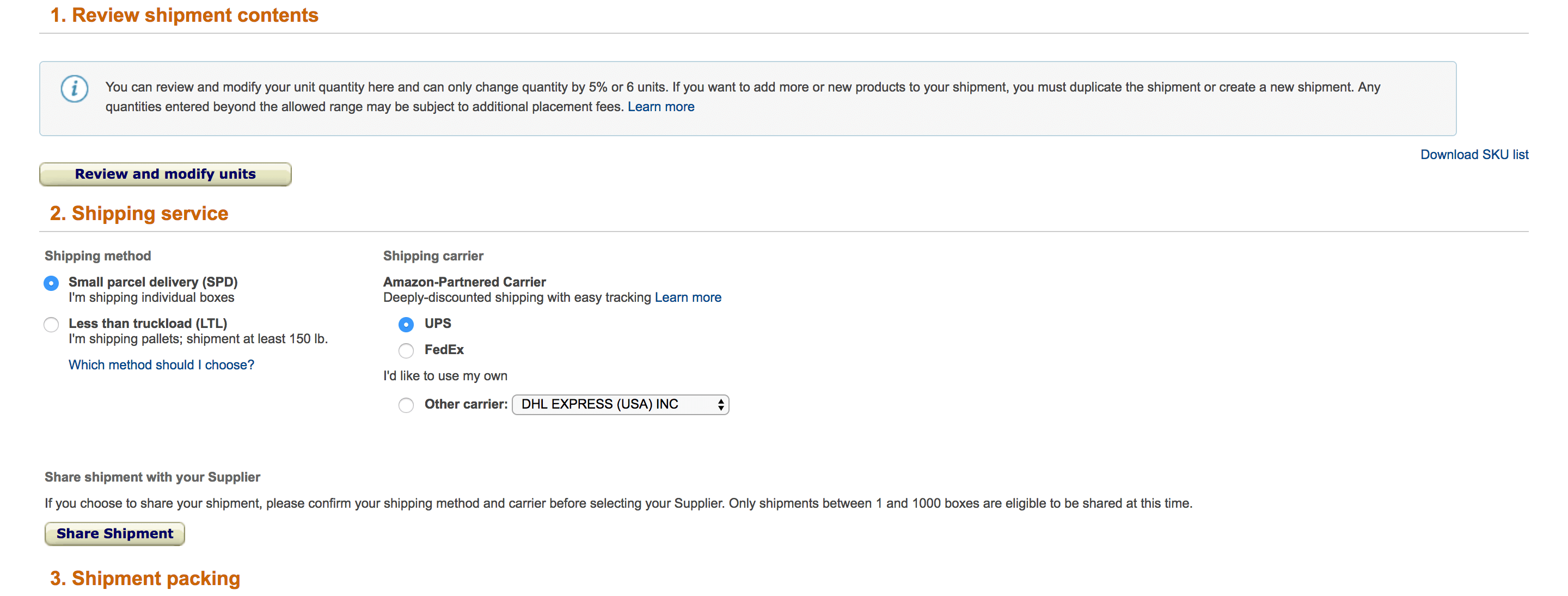
How do I set the final delivery method?
UPS:
- Select “Small Parcel Delivery (SPD)” and “UPS”
- Complete the “Shipment Packing” section by entering the units per box, the number of boxes, and the box weight
The estimated shipping cost will be in the “Shipping Charges” section. Then, you provide Amazon FBA carton labels to your freight forwarder.
Amazon LTL:
- Select “Less than truckload (LTL)” and “Amazon-Partnered Carrier”
- Complete the “Shipment Packing” section by entering the units per box and the number of boxes
- Input the following as estimate information:
- Dimensions: Use 48” x 40” x 62” (maximum height per Amazon requirements
- Weight: Divide the cargo weight by number of pallets
- Approximate pallet count: Divide the shipment’s volume (cbm) by 1.5
- Complete the “Shipping Charges” section and click “Calculate”
| Shipment Size | Delivery Method | Transit Time | Palletization | Things to Consider |
| SPD (Small Parcel Delivery)
≤ 30 cartons |
FedEx | Next business day to
local area |
Not required | 200 carton limit per shipment ID
Only UPS is available in Canada |
| LTL (Less than Truckload)
> 30 cartons |
Amazon LTL | 2- 3 weeks from when goods are available
for pick-up |
Flexport will palletize per Amazon’s specifications | 26 pallet limit
Not available in Canada |
| FCL (Full Container Load)
At least one container |
FCL Direct Delivery | Within 7 business days from when goods are available for pick-up | See “Setting up Flexport FCL” | All products must be assigned the same fulfillment center |
Your freight forwarder may be able to provide trucking services that are faster, although more expensive.
How do I package my goods for shipping to Amazon?
- Make sure your goods are wrapped or sturdily contained
- Wrapped in some sort of plastic or casing, so they aren’t covered in carton cardboard dust by the time they reach your customer
- Ensure the wrapped units are positioned in the master carton to minimize empty space
- Stuff padding in the cartons to fill up any space to prevent the units from bumping into each other and shifting in the carton
- Seal the cartons well so units will not shift out
- Make sure your master carton is structurally sound to support any extra weight and to protect it against mishandling
- Fill up any empty space in the master carton – you want the packaging, not your goods, to absorb any shock your shipment encounter
Should I ship via pallet?
- If your cargo is fragile (think glass or electronics), palletize at origin to keep your cargo more secure
- If your cargo is not fragile, palletize cargo stateside, because pallets are heavy and will add a significant amount to your freight costs
How do I label my products for Amazon FBA?
Ask your supplier to apply the unit labels (FNSKU) at their factory:
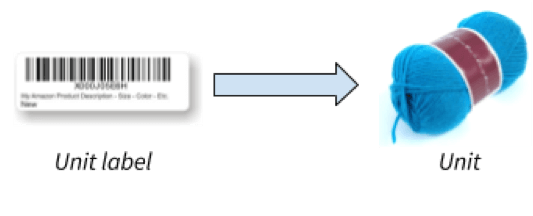
You generate the Amazon FBA carton labels in Amazon Seller Central:
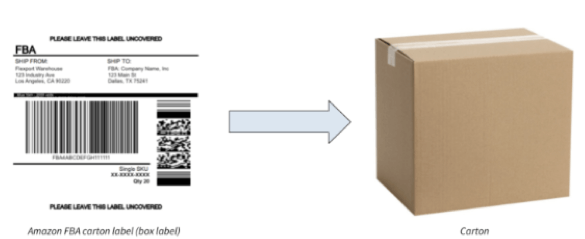
If you’re using UPS or FedEx, each carton should also have a UPS/FedEx label, which is generated in Amazon Seller Central.
If you’re using Amazon’s LTL trucking service, pallet labels will be applied at the destination warehouse.
How can I track my shipment?
- If you’re shipping to Amazon with UPS, you can track your shipment on Amazon Seller Central
- If you’re shipping to Amazon with Amazon LTL, you can track your shipment on the carrier’s website using the PRO# on the trucking bill of lading (B/L)
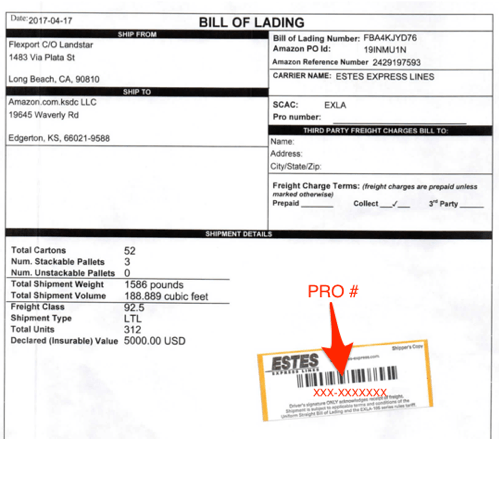
How long does it take to ship from China?
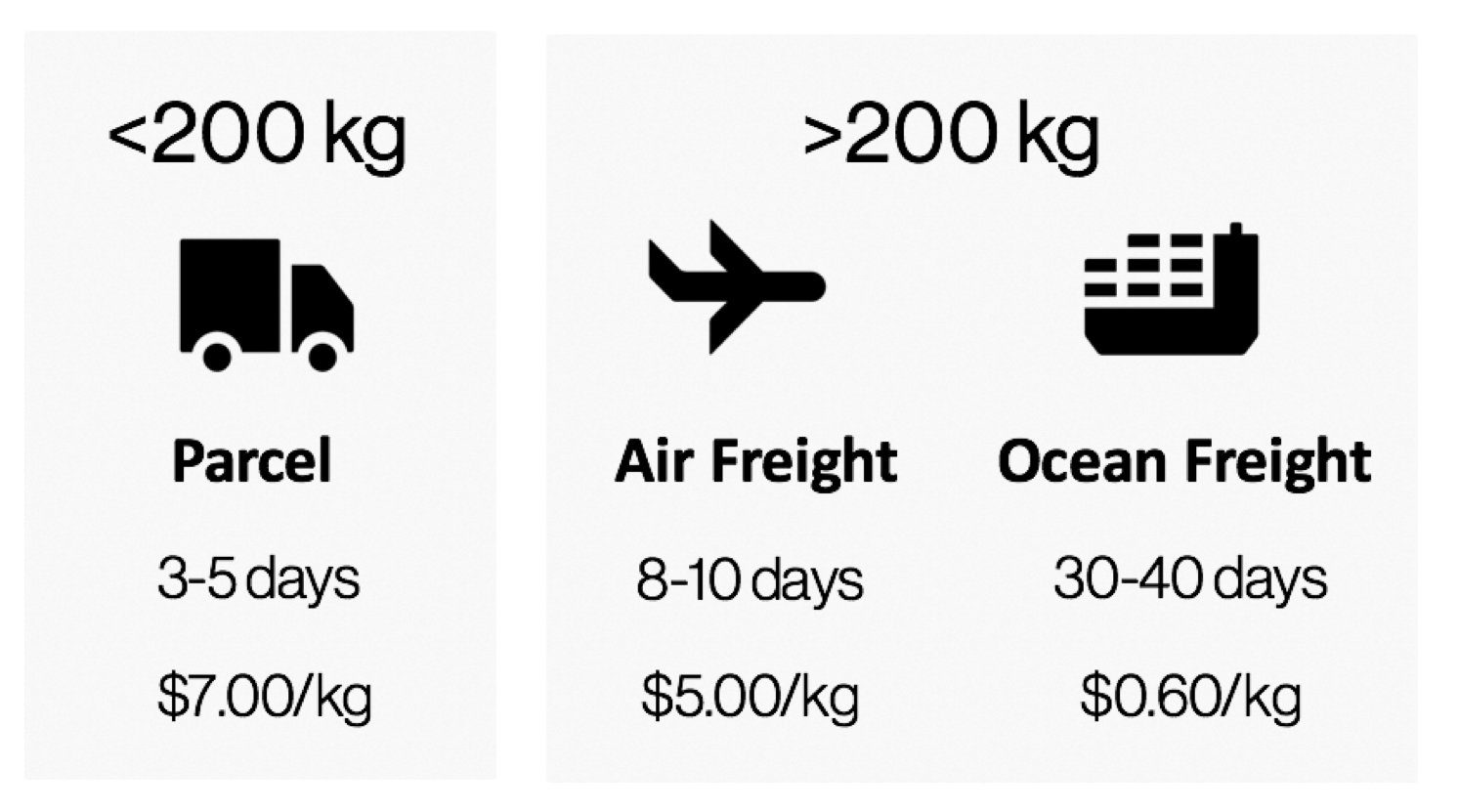
How do incoterms work?
- You and your supplier set incoterms
- 11 incoterms, but the most common are FOB and EXW
- FOB (Free on Board) – The supplier is responsible for getting your goods from the factory to the port. This cost is added to manufacturing cost.
- EXW (Ex Works) – The freight forwarder is responsible for getting your goods from the factory to the port.
Should I buy freight insurance?
- Always buy freight insurance because:
- 50% of freight claims are denied by carriers
- Your cargo will pass through many hands and places before it gets to you, increasing the chances of damage
- If damage or loss occurs, carriers will do their best to limit their liability or avoid it altogether, even if they are at fault
- Cargo insurance will cover your shipment from pickup to delivery, across multiple carriers and modes, and it covers the value of your goods as well as what you have paid for freight and other costs associated with the cargo
What shipping documents do I need to know about?
- Telex release – an email sent from the point of origin to the destination port that allows the carrier at destination to release your cargo without presentation of the original bill of lading
- Eliminates the need for an original bill of lading to be presented at the destination for the release of the goods
- Bill of lading – the ticket that outlines the journey of your cargo from origin to its destination
- The carrier issues a set of three original bills of lading, one of which must be endorsed by the consignee and physically mailed to the receiver of the goods so they can obtain the cargo at destination
- Commercial Invoice:
- Needed to clear shipment through U.S. Customs
- Needs to contain:
- Country of origin/manufacture
- Full name and address of Importer of Record
- Full name and address of supplier/manufacturer
- Complete description of merchandise in English
- Quantity of units for each product
- Unit value of each product, including currency declaration
- Total extended value, including currency declaration
- Packing List:
- Information must match what is listed on the commercial invoice
How can I get my inventory through customs?
- Give your freight forwarder the commercial invoice, packing list, and/or product information
- Be as accurate and detailed as possible so your customs broker can correctly classify your goods to help avoid holds at Customs
- Customs select shipments at random to undergo Customs exams, but you can minimize your risk by making sure that your paperwork matches up perfectly with your shipment
What happens during peak seasons?
- Expect high, volatile rates, rolled cargo (cargo is moved to a later shipment due to a lack of space on the scheduled carrier), trucking delays, and other interruptions
- Plan ahead
- Book carriers early and expect to need more time to load/unload at origin and destination because of congested ports and warehouses
- Book shipments 7-10 days before they are ready at your supplier
- Prepare for extra fees as a result of congestion
- Trucking wait fees
- Chassis shortages
- CFS (container freight station) fee
- Pickup and Delivery Fees
The TL;DR version of shipping goods to Amazon:
Here’s an easy to follow step-by-step rundown of how this process should go for you, the seller:
- Find a freight forwarder and get set up with them ready for your first shipment
- Create a shipping plan in Seller Central on Amazon
- Notify your freight forwarder of the approximate date the goods will be ready and get a quote
- The freight forwarder then communicates with a representative at your factory to get the goods on the vessel
- It takes a few weeks for the shipment to arrive via ocean freight
- Then your freight forwarder will unload the container and palletize your products for Amazon
- A truck will pick up your pallets and take them to the Amazon distribution center
So realistically, you will pay your freight forwarder to handle all of the difficult parts for you. The key is to ensure you have a good relationship with them, communicate frequently, and be flexible in case they need any information from your or your supplier.
EXCLUSIVE Jungle Scout Discount from Flexport
If you’re in the market for a freight forwarder I would highly recommend you give Flexport a shot. I have been using them for some time now and I must say they make this whole process of getting my goods to Amazon a sinch. PLUS, we have negotiated a special rate for our Million Dollar Case Study viewers. Check them out:
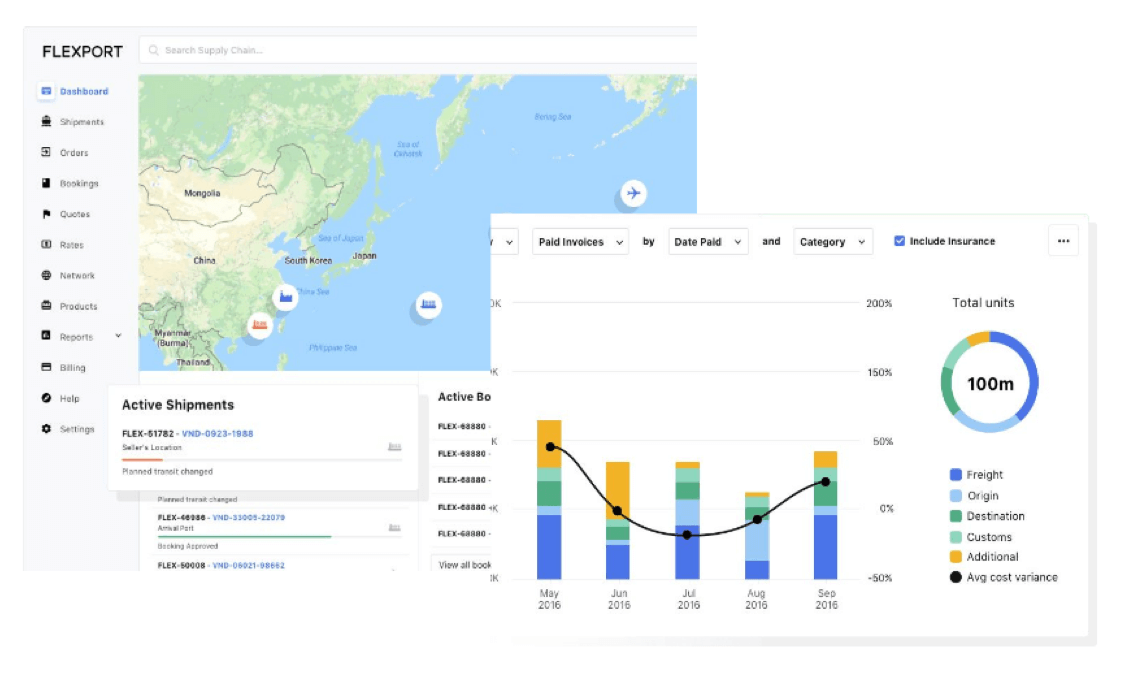 Now, it’s YOUR TURN!
Now, it’s YOUR TURN!
Start selling on Amazon today
Your Amazon success starts with Jungle Scout.
Start doing some research of your own! With every blog post, we’ll be challenging you with “Action Items” to make the most of your MDCS journey.
This weeks Action Items can be found here, in your FREE MDCS Workbook!
After you’ve completed your Action Items, post your progress to the Million Dollar Case Study Facebook Group! You don’t have to reveal all of your best ideas – just let us know you’re working on them! You can also post them to Instagram with the hashtags #mdcschallenge or #freedombuilders.
We donate 100% of our product proceeds to Pencils of Promise.
They build schools in developing countries to help children get access to the education they need for a strong foundation.
We love doing the Million Dollar Case Study. It’s a team-wide effort and we value every opportunity it gives us to connect with sellers like you.
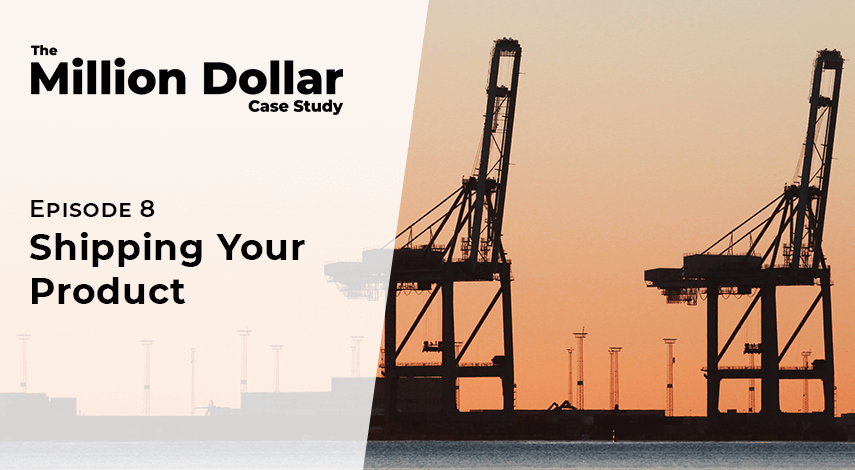
 81 Comments
81 Comments
81 comments on “Million Dollar Case Study: How to Ship Your Product from China to Amazon”
If my shipment is sent by my shipper in chine directly to the amazon fulfillment center via DHL or any other carrier, what address do I put in my plan?
Hi,
I suggest working with a freight forwarder to help you get your products from your supplier directly to Amazon.
Hi. How do I go about ddp shipping? How do I get an Amazon warehouse address for my supplier to send to, if the supplier is taking care of the shipping?
Hi Rachel,
Check out this article here: https://www.junglescout.com/blog/international-freight-for-amazon-fba/
Hi, how do you choose which port to deliver your goods via sea freight? Does it matter which port of arrival we choose to send our products? Thanks
Hi Dassa,
If the final location of your inventory is Amazon, then it shouldn’t matter which port you deliver to. If you need to deliver to your location after delivery to port, choose a port closest to you.
Amazing article! I’m stuck on the “Ship From” address as my freight forwarder doesn’t have a loading warehouse at the port of entry. They keep telling me to use my supplier’s address in China as the “Ship From” address which I believe is incorrect. Any ideas on what address I can use?
Thanks in advance!
Hi Matt,
Check out our video on this topic: https://www.youtube.com/watch?v=QwDYqTJNJbA&t=972s
This should help!
It’s really a 10 Million Dollar Case Study information. Very impressively detailed and very helpful blog.
Appreciated.
Thanks for reading!
Hello,
Quick question regarding the SPD option.
Please, let me know if once I agree to the terms and conditions, accept charges, print box labels for the supplier to apply them, do I have the option to schedule the UPS collection from the freight forwarder distribution centre/warehouse or I receive an automatic window on which at the end the goods has to be ready for collection?
Thank you in advance for your help.
Kind regards,
Sorin
Hi Sorin,
Once you have your labels ready to go, send them to the distribution center so they can label and schedule a UPS pickup for you.
Thank you very much for the great details! I have a question about the shipment method. What do I need to select in “Shipping Service” if I have chosen the DDP method?
When you are creating a shipment in Seller Central?
Thanks Dave for this great article.
I actually ship by sea freight from China to Amazon warehouses in the US every month or so and I use this forwarder called CNXtrans (www.cnxtrans.com) as they offer DDP sea freight to US Amazon warehouses. Because it’s DDP, they take care of the whole door to door shipping including the customs, duties and the domestic delivery to the Amazon warehouse. This saves a lot of hassle since I don’t have to clear customs myself / look for a customs broker or arrange the domestic delivery myself. The whole process normally takes about 30-35 days.
So for those looking for door to door shipping, I would recommend this forwarder.
Cheers,
Nick
Hi Thanks for all the info. I have two shipments ready to go in China, with FNSKU labels. One is an FCL and the other LCL.
Products ceramics and wood. I contacted several logistics companies but most do not reply (maybe a “thanks for your inquiry, we will get back to you”.) Amazon now tells me they will only accept 200 units. I have tried to find a logistics company in the US who will store and replenish stock to Amazon. The same stonewalling. Some companies can not be reached by email, telephone or fax even though they profess to be major players in the US. This is unacceptable. How long do I have to wait before I get some action?
Thanks for the detailed information!! What labels should be on the outside of the carton. I’m getting ready to send a shipment into Amazon and my supplier wants to know what marks I need for the cartons. It should say “Made in China” right? Is there anything else I should have on the cartons?
Hi Natasha,
Thanks for the question! I would ask them what they mean about the markings. The only thing really should be the weight, dimensions of the box, and then the shipping label.
Hi,
this has been asked before but I don’t think has been answered.
I am not a US citizen and don’t reside in the US. Will Amazon USA accept me as a seller, and will I still be able to have products imported and shipped to Amazon?
Hi Steve,
Thanks for the question!
Yes, you can sell on Amazon US even if you do not reside in the USA. Currently, Amazon U.S. accepts sellers from 102 countries around the world. You can get more info from Amazon’s help center.
You can also check out this post to get more info on this topic! https://www.junglescout.com/blog/how-to-sell-on-amazon-from-overseas/
Brian
Hi,
For shipping charges, if I select SPD and UPS:
1) If we accept shipping charges, i assume we will pay to AMAZON for the estimated charges? If so,
2) Any chances for supplier to charge us for shipping additional?
thanks.
Hi Willie,
You will pay those charges to Amazon and it will come out of your balance. The shipping charges you see in seller central will be what the exact cost is. You can choose to hit “accept” or not.
I’d like to better understand what happens when you don’t use a freight forwarder. My initial shipment is expected to be <200 KG. Without the freight forwarder, how do I manage the customs process? Further, how do I determine the "Ship From" address when setting up the Shipping Plan on Amazon Seller Central? Will my supplier provide this information? Thank you in advance.
Hi Chris,
The best and most reliable way to get your items shipped directly from China to an FBA warehouse is to use a freight forwarder. Or you can do an air shipment directly to your location and then ship to FBA yourself.
When you were talking about a shipment and you said that you have to put Amazon address on ship from so, what about ship to ?
Hi Damach,
Interesting question. I’m not sure what you mean. Could you elaborate?
Hey guys! Thanks for the awesome video!
So from what I understand the freight forwarder can offer to deliver the goods from China warehouse directly to Amazon’s warehouse? I would suppose that will cost more than just deliver the good to USA port or airport.
In this case, if we chose the freight forwarder to deliver directly to Amazon’s warehouse why do we have to pay to Amazon for the shipping when creating our shipment plan.
I am missing something here, but not quite sure what.
Would appreciate if anyone can give some insights, thanks! 🙂
Ion,
Yes, Basically, the freight forwarder would be shipping your goods DDU (door-to-door unpaid taxes). So on top of the cost to ship it via a boat you’d have to pay to truck it.
Also, you shouldn’t have to pay Amazon’s shipping amount if you’re selecting your own carrier. There should be an option in there when you’re creating your replinishment order.
Hello,
Many thanks to the whole Jungle Scout Team for all the valuable content and the great tool! It is a great help for new sellers and makes this whole journey so much easier! I used Jungle Scout to find my first supplier, and feel confident because i have a proof that they have experience importing to US before and that they are definitely not a scam. That does help me sleep better at night 🙂 🙂
I have a question – our plan is to ship our goods via Air from India using a freight forwarder and then via the discounted UPS service straight from the airport (LAX) to the designated Amazon whse. Do you know how exactly it is arranged for UPS to pick up the goods from the airport here is US? Meaning, where do the goods go right after they are unloaded from the plane and who is supposed to give them to the UPS driver?
Thanks in advance for your help
HI, my MOQ is 1000 but Amazon will only let me have 300 inventory. What is the best way to negotiate this? Should I get 3 boxes sent to me/storage?
Hi Lucy,
What you might consider doing is shipping all of the products directly to you first, then send just what Amazon allows you. Typically, once you demonstrate that the inventory is selling, Amazon will increase the number of products that they allow in their warehouses.
Great Content!
Without any doubt, this is the best blog I have read about amazon FBA and even learn many new things about FBA service. They have well explained in details and content will be very full for many new FBA sender.
“So, I’m currently dealing with a supplier that specifically deals with EXW for the international trade. I’m purchasing 500 units total and the weight of all the products will total up to 135kg (under the recommended 200kg mark when trying to utilize freight forwarders). My question is, do I still need a freight forwarder at this point? Will the supplier just send the shipments to Amazon’s warehouse? Obviously, I’m new to this process and I’m looking for some guidance. How should I handle this? I would greatly appreciate the help! Thank you!”
Also, to add to my previous comment above. I know you mentioned to not use the manufacturers address as the source mailing address but, how would I obtain the port of entrys address? Should I contact the manufacture for that information?
Thanks, we will recommend Jungle Scout to other online sellers
Great Post! – Do you happen to know any good shipping companies to ship goods from Pakistan to the USA?
Andrew
Interesting question. Do you mean you’re buying products in Pakistan to sell in the US, or you’re a seller in Pakistan buying somewhere else to ship in the US?
Hi there, love your content,
what does the TL:DR mean in the following statement ?
“The TL;DR version of shipping goods to Amazon”
I kinds think it might be a typo, or maybe it is term I don’t know
Thanks, Matt
Hey Matt!
TL;DR is a slang abbreviation meaning “too long, didn’t read” which basically means we’re giving a concise summary of the post in case you skim through and don’t read it all 😉
It’s a little more common in online publications, so now you know!
Just read an article regarding SMETA audits and would like to know if you guys think if this accreditation is important for amazon sellers?
https://www.v-trust.com/SupplierEvaluation/smeta-audit.aspx
Hi Dominic,
I’m not familiar with it, but it looks like this type of audit goes deep to assess the ethics, working conditions, and environmental impact of a supplier’s facilities. I’d think if those issues are important to a seller, and you’re setting up a long-term business relationship, it would definitely be worth looking into.
There is no requirement or set standards from Amazon or Alibaba at this time on those matters, but that could always change. It’s a personal preference at this point. I’m glad to hear it’s an option though, I’d feel better if I knew my business wasn’t harmful to the environment or anyone involved.
Thanks for sharing!
Melissa
If the shipment is less than 200 kg you don’t use a freight forwarder, yet in the ship from address it only gives the example of a freight forwarder. They say not to use the address of the supplier. What address do we use? If it’s the address of the port of entry, how do we get the shipment from the port of entry to Amazon’s warehouse?
May I know why you tell people do not use the supplier’s address as Ship From address for shipping plan. The truth is a lot of people are using the supplier’s address as Ship From address and their frieght fowarder help them send goods directly to Amazon warehouse. This is very confusing to Amazon new sellers like me.
Hi,
Would you please answer my question below just to confirm
So my parcel is only 9kg and im using express shipping. From the video i feel like that means i only make a shipping plan get the final address of the amazon warehouse i will be sending my goods into and give that address to my supplier? I have one 1 barcode (FBA) after completing my shipping plan on amazon fba.
I dont know if express shipping means only shipping the goods to the uk or to the final destination (warehouse) and dont want my parcel to get lost somewherem. hope you reply. thanks
When deciding how to ship to Amazon you mention less than 30 cartons use SPD and more than 30 cartons use LTL. I am assuming that “cartons” and “boxes” can be used interchangeably here? Does it matter how big the boxes are?
For example, I have 3 different sized units small, medium, and large, that are being shipped. Each size has 31 boxes but the boxes for each size are different. According to this article, there are more than 30 boxes so I should ship LTL? Does it matter that some of the boxes are relatively small? For the small size, the package dimensions are:
Total boxes = 31
Total packs per box = 8
Box dimension: 15″ x 15″ x 8″ Inch
Gross weight : 23 lbs per box
Thanks so much : )
Nice read.
Flexport will not work with new FBA businesses. You must have history of at least 10 shipments per year for them to work with you.
Hello,
What “ship from” address are you supposed to use when you are still getting quotes from different freight forwarders?
The article mentions not to use the suppliers address so what port of entry warehouse address should you use?
We contacted one of those QC companies you recommended, V-Trust, and their report is very detailed. We wish we knew about this before. OMG! We had some major problems with our supplier, and now the nightmares are gone.
Thanks, Dave!
Hello Rolando, thanks for the recommendations regarding inspection companies. How come we didn’t know pre-shipment inspections before? We now use one of the companies you recommended, V-Trust, and their reports are fantastic. We’ve got no more headaches! Cheers!
Hi,
Do you have any recommendation for the controller to check my goods in China
Thanks
Stasy
Hi Stasy
You can find the recommendation companies in the article. yet lots of inspection company you can choose and find a suitable one.
Great Post! I’m following the MDCS closely and I truly find it inspirational.
I’m at a critical point as a first time buyer and importer in FBA. My product is small and lightweight – total order weight of ~148 kgs. According to my research and a few calculations, air courier / express is my best option. To get a DDP / air courier quote from my supplier, they need the address of the AMZ FC assigned to this order where the goods should be delivered.
The problem is that I am stuck on preparing a shipping plan in Amazon’s Seller Central. As I understand it, the “ship from” address is supposed to be the Freight Forwarder’s address or my business / home address. However, since I would be shipping from the factory straight to AMZ FC, I would think the correct address would be the Chinese Factory’s address, but allegedly, If I use the factory’s address it will affect which and how many AMZ FC the load gets assigned to.
Considering the product load is going directly to AMZ FC (without using AMZ shipping partners’ services inside de US), does the “Ship From” address really matter? Which address should be used for the “Ship From” field?
Any advice would be greatly appreciated.
So if shipping spd with cartons. Do you get your freight forwarder to apply box labels stateside? And same if it’s lcl for pallet labels?
Hey Matt,
Yes. Unless I’m shipping it to myself, then I do it.
Hi,
I registered my account to create my listing and a shipping plan, but my account has been suspended before I could do anything and I don’t know why. I’ve sent a lot of e-mail to the support team seller, but no answer. I’m not a US resident, but I would like to sell in the US. Do you know how to reach Amazon to have some answer?
Thanks for your help.
FT
Hey guys,
Thanks for such a great show and excellent info.
I’m sending some products air express from the supplier in China. Is it correct to assume all the customs, duties and so forth are going to be taken care of on the supplier’s end or with the freight company, such as DHL? I’m wondering if I should get other people involved, like a freight forwarder. I’m new at this! (obviously!).
Hi Michael my question is about shipping to Amazon FBA during December/January. Is it to late to ship into Amazon FBA as I’m guessing room would be limited with all the stock coming in? And would the freight forwarder be aware of this?
Thanks for chatting with us
Regards,
Whitu
Hey,
Thank you very much for your valuable great content.
I have paid my supplier for DDP services, does it mean all I have to do on my side is give him the address Amazon asks me to ship to and labels? And on “work on shipment” I am supposed to pick by “other” and be charged $0 because he is already doing everything for me?
Liran,
That should be yet. Just give them the labels. And yes. Pick other.
I just did similar. So if I’m wrong, we’re both wrong! Haha! (But seriously, yes. 🙂 )
Hi guys,
I’m trying to figure out a good way to get quotes to ship air express to Amazon from the supplier to get started selling right away, while I wait for a larger order to arrive later. The problem is, I’m trying to determine if there’s enough profit margin before (obviously) I place an order. So, I don’t know how to give the supplier a shipping address to Amazon to calculate the express freight costs. Any ideas? What do you recommend?
Hey Fred,
In my experience, LCLs usually run roughly $0.50-$1.00 per unit, whereas air freight can sometimes be as much as $1.50 per unit. All of that is subjective, of course. But if you’re selling lightweight, small products (that can fit roughly 30-40 per carton) that’s usually what you’re looking at.
Hello.
1stly thanks very much for really great and valuable informations. I am following now this series and I have a question about the taxes.
As said in this part when total weight is less then 200kg then we can send direclty to Amazon. Then who will be making custom clearance for me? And if I am not a company and I am not US citizen then can I again do this business?
Hi Hiloliddin,
Depending on who handles the logistics, it will be provided by either the factory’s or Fex Ex (DHL, UPS, etc) customs agent. You might also look into a third party to help you with shipping/customs.
Hi, i have a question – I am in Australia, can I still do the Amazon, if so how do I do it, any registration formalities in US do I need to do? Thank you. Victor
Inorder to import my shipment in US to deliver it to Amazon warehouse, whether I need any legal documents since I am a non US citizen.
Hi!
In an old post I read about the services of FreightOs. https://www.junglescout.com/blog/international-freight-for-amazon-fba/
In your experience, based on fees and service, can you highlight the differences?
I am considering both companies today, but I have not decided yet. FreightOs expose some information what I fing really cool, but Flexport is very close if you are not a validated customer.
Regards, Albert
Hey Albert,
Have you been following our Million Dollar Case Study? We just sat down with Flexport in a recent episode and discussed a lot of your shipping options with much more up-to-date info that should help you make a decision.
Hope you find the episode helpful!
Melissa
Hello,
How would the shipping plan change if I were to ship a small set by air directly from the supplier?
e.g. what address do you put? the supplier’s address? who would then take care of the custom bonds, and other legal documents?
Mac,
You can hire a third party logistics coordinator to do that, or you can use the folks whom you ordered from. They usually have their own inhouse person that can do all that for you.
Hello
If I want to ship a small quantity by air to arrive to amazon early, what should be the shipping from address to put in the shipping plan? Supplier? FedEx? Other courier?
Thanks
Hey Mac,
Have it ship from the supplier’s address. Ask them and they should give to you. Most suppliers are pretty experienced with dealing with FBA stuff.
Okay so you would use your supplier’s address in this case. “If your cargo is less than 200 kg, then you can go through your supplier, who will leverage DHL Air Express.”
I was a little confused when I saw I read this. “Do not use the supplier’s address. Use the final destination your product will land at before going to Amazon – like the offloading warehouse at the port of entry.”
Hi Craig,
Great question.
Typically, I contact the supplier and ask them what address I should use. Once I have that information, I put it in there going to either Amazon or my own quality control center (aka my garage).
Hope that’s helpful!
Hey guys , the telex release so it’s a sort of fast track for customs that can speed up the process? How do I get the telex release? Is it free?
What are some rough estimates for trucking wait fees??
Hey James,
Hard to say. Most of the time it’s more about the volume than the weight.
Hello,
When setting up the shipping plan and entering the number of cases and units per case, what do you do if you have all cases the same, except for the last one, which has less?
in my case, I have 2000 units (of the same product), and the supplier is putting 6 into each carton. So I will have 333 cartons containing 6 units and 1 carton containing 2 units?
thanks
Hey Markam,
Good question. Used to be you could just send it and Amazon was cool with it. But they’ve recently changed their policy re: that. Separate out the 1 carton and do a different fulfillment for it with different weight/dimensions, etc. Then have the logistics person send them all as one. That shooooould work.
Hello, I receive all other emails from JS like about the webinar etc but when I try to get the workbooks and enter my email then I never receive emails about that. I checked my spam folder etc.
Thanks for doing this wonderful series.
Rav
Hi Rav,
We’ve heard several people have had download issues so we’ve included the direct link to the MDCS workbook in the blog post. You can also grab it here. Thanks for bearing with us!
Melissa
Hi Melissa,
The resources section in this workbook is great but is there a US version?
Thanks,
Ken